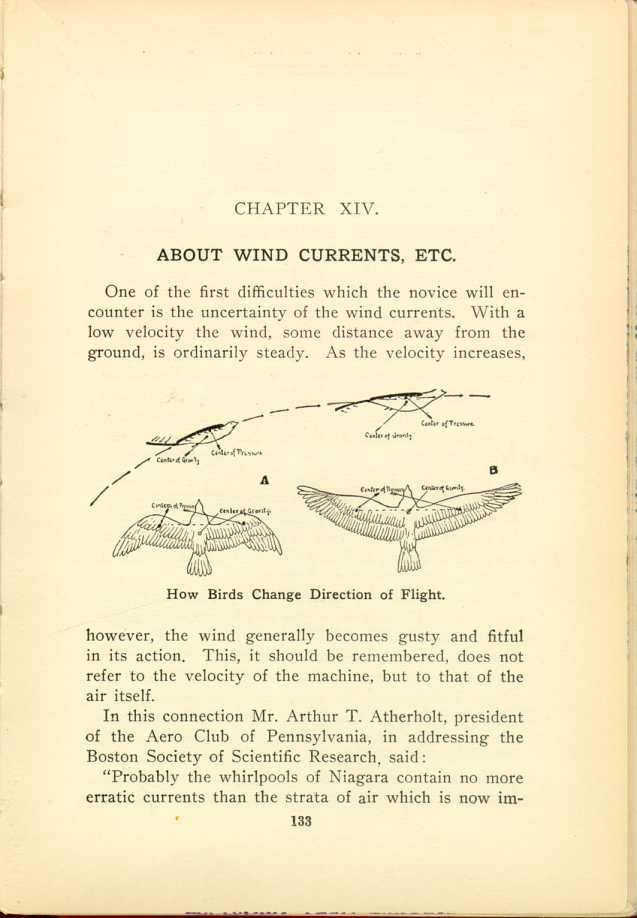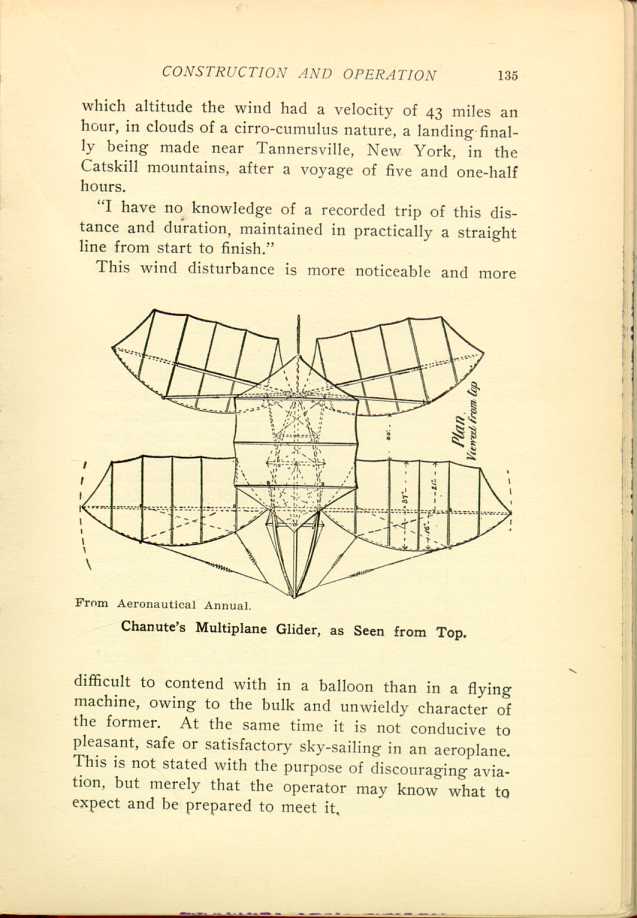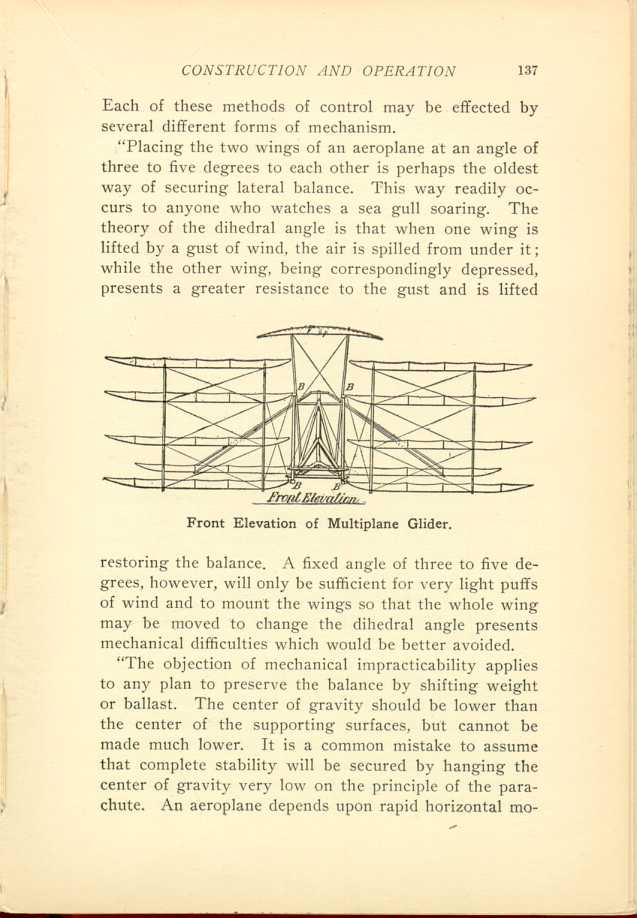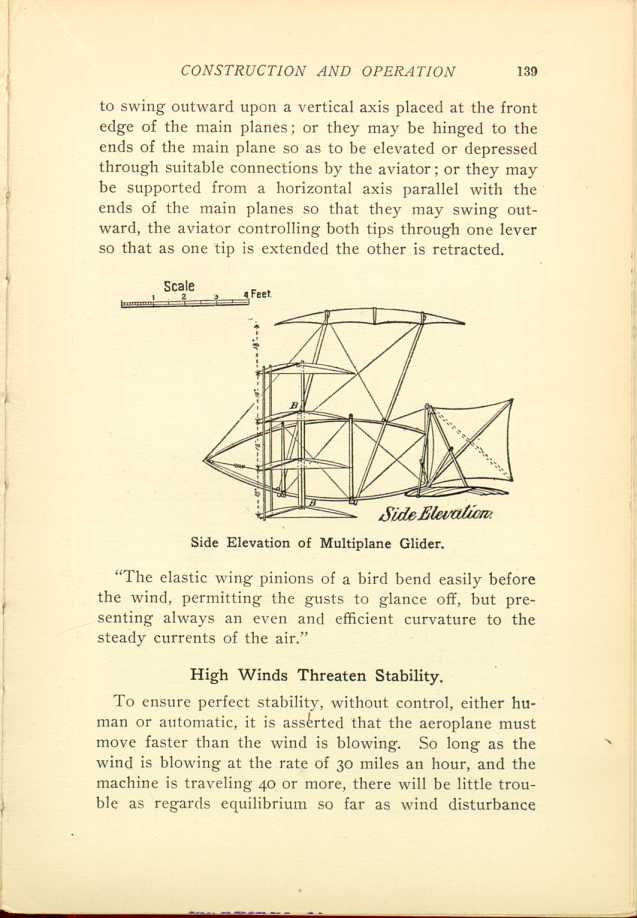14. CHAPTER XIV.
ABOUT WIND CURRENTS, ETC.
One of the first difficulties which the novice will
encounter is the uncertainty of the wind currents. With a
low velocity the wind, some distance away from the
ground, is ordinarily steady. As the velocity increases,

How Birds Change Direction of Flight.
[Description: Black and white illustration: Four-part diagram of bird in
flight.]
In this connection Mr. Arthur T. Atherholt, president of the Aero Club of Pennsylvania, in addressing the Boston Society of Scientific Research, said:
"Probably the whirlpools of Niagara contain no more erratic currents than the strata of air which is now immediately
Changes In Wind Currents.
While Mr. Atherholt's experience has been mainly with balloons it is all the more valuable on this account, as the balloons were at the mercy of the wind and their varying directions afforded an indisputable guide as to the changing course of the air currents. In speaking of this he said:
"In the many trips taken, varying in distance traversed from twenty-five to 900 miles, it was never possible except in one instance to maintain a straight course. These uncertain currents were most noticeable in the Gordon-Bennett race from St. Louis in 1907. Of the nine aerostats competing in that event, eight covered a more or less direct course due east and southeast, whereas the writer, with Major Henry B. Hersey, first started northwest, then north, northeast, east, east by south, and when over the center of Lake Erie were again blown northwest notwithstanding that more favorable winds were sought for at altitudes varying from 100 to 3,000 meters, necessitating a finish in Canada nearly northeast of the starting point.
"These nine balloons, making landings extending from Lake Ontario, Canada, to Virginia, all started from one point within the same hour.
"The single exception to these roving currents occurred on October 21st, of last year (1909) when, starting from Philadelphia, the wind shifted more than eight degrees, the greatest variation being at the lowest altitudes, yet at no time was a height of over a mile reached.
"Throughout the entire day the sky was overcast, with a thermometer varying from fifty-seven degrees at 300 feet to forty-four degrees, Fahrenheit at 5,000 feet, at
"I have no knowledge of a recorded trip of this distance and duration, maintained in practically a straight line from start to finish."
This wind disturbance is more noticeable and more

From Aeronautical Annual.
[Description: Black and white illustration: Glider, from above.]
Chanute's Multiplane Glider, as Seen from Top.
Not only does the wind change its horizontal course abruptly and without notice, but it also shifts in a vertical direction, one second blowing up, and another down. No man has as yet fathomed the why and wherefore of this erratic action; it is only known that it exists.
The most stable currents will be found from 50 to 100 feet from the earth, provided the wind is not diverted by such objects as trees, rocks, etc. That there are equally stable currents higher up is true, but they are generally to be found at excessive altitudes.
How a Bird Meets Currents.
Observe a bird in action on a windy day and you will find it continually changing the position of its wings. This is done to meet the varying gusts and eddies of the air so that sustentation may be maintained and headway made. One second the bird is bending its wings, altering the angle of incidence; the next it is lifting or depressing one wing at a time. Still again it will extend one wing tip in advance of the other, or be spreading or folding, lowering or raising its tail.
All these motions have a meaning, a purpose. They assist the bird in preserving its equilibrium. Without them the bird would be just as helpless in the air as a human being and could not remain afloat.
When the wind is still, or comparatively so, a bird, having secured the desired altitude by flight at an angle, may sail or soar with no wing action beyond an occasional stroke when it desires to advance. But, in a gusty, uncertain wind it must use its wings or alight somewhere.
Trying to Imitate the Bird.
Writing in Fly, Mr. William E. White says:
"The bird's flight suggests a number of ways in which the equilibrium of a mechanical bird may be controlled.
"Placing the two wings of an aeroplane at an angle
of
three to five degrees to each other is perhaps the oldest
way of securing lateral balance. This way readily occurs
to anyone who watches a sea gull soaring. The
theory of the dihedral angle is that when one wing is
lifted by a gust of wind, the air is spilled from under it;
while the other wing, being correspondingly depressed,
presents a greater resistance to the gust and is lifted

Front Elevation of Multiplane Glider.
[Description: Black and white illustration: multiplane glider from front.]
"The objection of mechanical impracticability applies to any plan to preserve the balance by shifting weight or ballast. The center of gravity should be lower than the center of the supporting surfaces, but cannot be made much lower. It is a common mistake to assume that complete stability will be secured by hanging the center of gravity very low on the principle of the parachute. An aeroplane depends upon rapid horizontal motion
Preserving Longitudinal Balance.
"The birds maintain longitudinal, or fore and aft balance, by elevating or depressing their tails. Whether this action is secured in an aeroplane by means of a horizontal rudder placed in the rear, or by deflecting planes placed in front of the main planes, the principle is evidently the same. A horizontal rudder placed well to the rear as in the Antoinette, Bleriot or Santos-Dumont monoplanes, will be very much safer and steadier than the deflecting planes in front, as in the Wright or Curtiss biplanes, but not so sensitive or prompt in action.
"The natural fore and aft stability is very much strengthened by placing the load well forward. The center of gravity near the front and a tail or rudder streaming to the rear secures stability as an arrow is balanced by the head and feathering. The adoption of this principle makes it almost impossible for the aeroplane to turn over.
The Matter of Lateral Balance.
"All successful aeroplanes thus far have maintained lateral balance by the principle of changing the angle of incidence of the wings.
"Other ways of maintaining the lateral balance, suggested by observation of the flight of birds are—extending the wing tips and spilling the air through the pinions; or, what is the same thing, varying the area of the wings at their extremities.
"Extending the wing tips seems to be a simple and effective solution of the problem. The tips may be made
"The elastic wing pinions of a bird bend easily before the wind, permitting the gusts to glance off, but presenting always an even and efficient curvature to the steady currents of the air."
High Winds Threaten Stability.
To ensure perfect stability, without control, either human or automatic, it is asserted that the aeroplane must move faster than the wind is blowing. So long as the wind is blowing at the rate of 30 miles an hour, and the machine is traveling 40 or more, there will be little trouble as regards equilibrium so far as wind disturbance
One of the main reasons for this is that high winds are rarely steady; they seldom blow for any length of time at the same speed. They are usually "gusty," the gusts being a momentary movement at a higher speed. Tornadic gusts are also formed by the meeting of two opposing currents, causing a whirling motion, which makes stability uncertain. Besides, it is not unusual for wind of high speed to suddenly change its direction without warning.
Trouble With Vertical Columns.
Vertical currents—columns of ascending air—are frequently encountered in unexpected places and have more or less tendency, according to their strength, to make it difficult to keep the machine within a reasonable distance from the ground.
These vertical currents are most generally noticeable in the vicinity of steep cliffs, or deep ravines. In such instances they are usually of considerable strength, being caused by the deflection of strong winds blowing against the face of the cliffs. This deflection exerts a back pressure which is felt quite a distance away from the point of origin, so that the vertical current exerts an influence in forcing the machine upward long before the cliff is reached.
